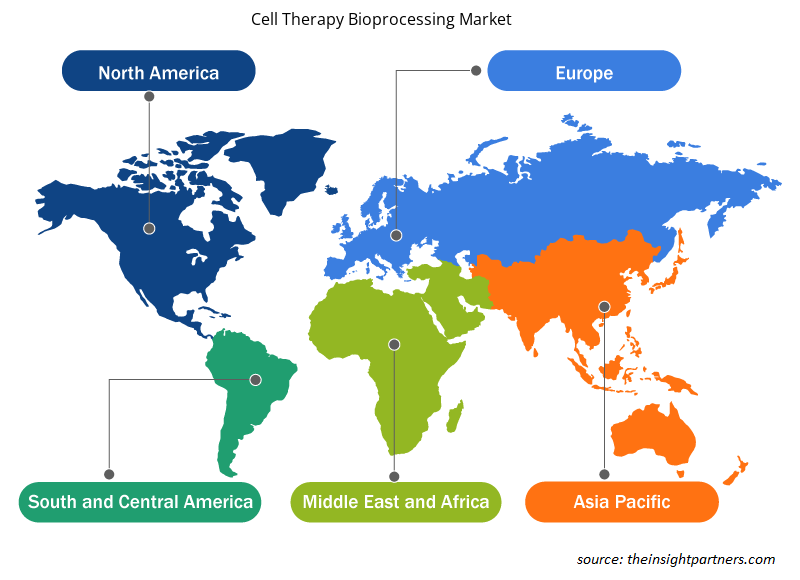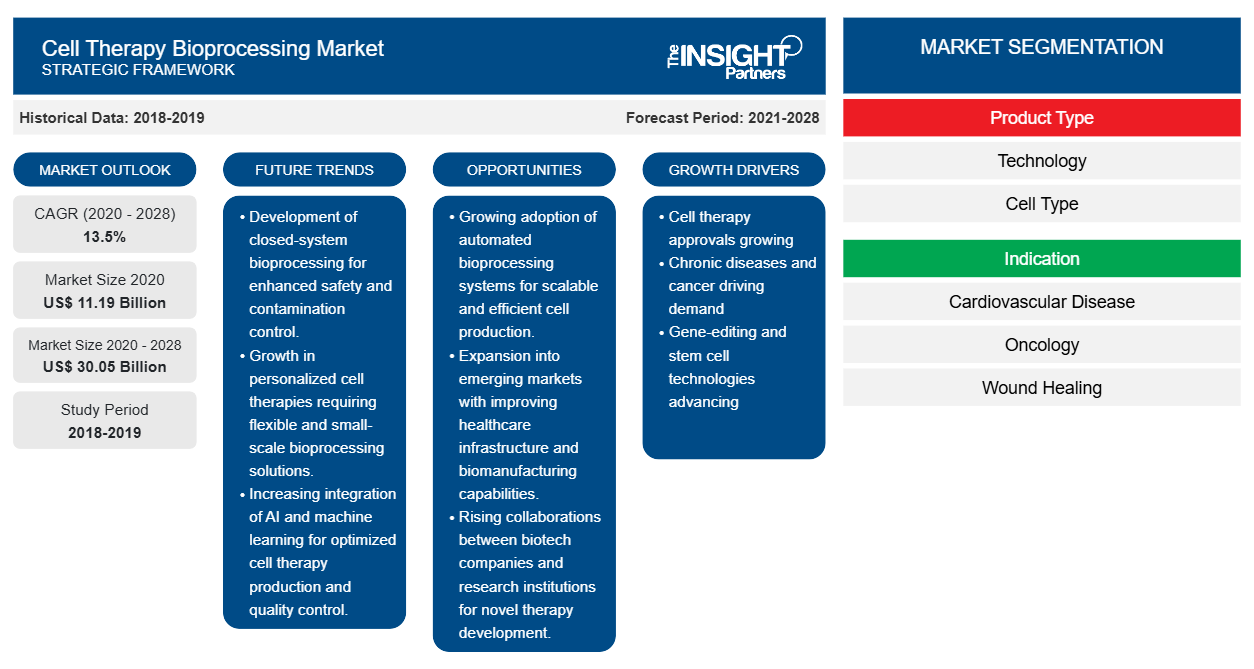Se espera que el bioprocesamiento de terapia celular alcance los 30.052,61 millones de dólares en 2028, frente a los 11.192,50 millones de dólares en 2020. Se estima que el mercado crecerá a una CAGR del 13,5 % entre 2021 y 2028.
El mercado de bioprocesamiento de terapia celular se ha analizado en función de la tecnología, el tipo de célula, el usuario final y la región. El mercado según la región está segmentado en América del Norte, Europa, Asia Pacífico, Oriente Medio y África, y América del Sur y Central. El informe hace hincapié en parámetros como las tendencias del mercado, los avances tecnológicos, la dinámica del mercado y el análisis del panorama competitivo de las empresas líderes para ofrecer información y un análisis en profundidad del mercado de bioprocesamiento de terapia celular . También incluye el análisis de la pandemia de COVID-19 en todo el mercado en todas las regiones clave.
Personalice este informe según sus necesidades
Obtendrá personalización en cualquier informe, sin cargo, incluidas partes de este informe o análisis a nivel de país, paquete de datos de Excel, así como también grandes ofertas y descuentos para empresas emergentes y universidades.
- Obtenga las principales tendencias clave del mercado de este informe.Esta muestra GRATUITA incluirá análisis de datos, desde tendencias del mercado hasta estimaciones y pronósticos.
Perspectivas del mercado
Aprobaciones crecientes para terapias celulares
Las terapias celulares han demostrado resultados positivos en el tratamiento de diversas enfermedades crónicas, incluidos los trastornos genéticos raros, al ofrecer medicamentos regenerativos y medicamentos personalizados. La creciente necesidad de tratar enfermedades crónicas ha impulsado las actividades de investigación y desarrollo, lo que ha dado lugar a un aumento de la producción de terapias celulares y de las aprobaciones de productos. A continuación se enumeran algunos ejemplos de las aprobaciones de terapias celulares que han contribuido al crecimiento del mercado de bioprocesamiento de terapias celulares.
- En mayo de 2019, la Administración de Alimentos y Medicamentos (FDA) aprobó Zolgensma, fabricado por AveXis, Inc., una subsidiaria de Novartis AG. Zolgensa está diseñado para tratar la atrofia muscular espinal en niños menores de dos años y se administra mediante una infusión única en la vena.
- En julio de 2020, Kite Pharma, Inc., una subsidiaria de Gilead Company, recibió la aprobación de la FDA para su Tecartus. Tecartus es una terapia de células T (CAR) diseñada para tratar el linfoma de células del manto (MCL) refractario en adultos. Según Gilead Company, Tecartus es la primera terapia de células T (CAR) aprobada para el linfoma de células del manto, que se espera que sea una nueva frontera en el tratamiento del linfoma de células del manto.
- En febrero de 2021, Juno Therapeutics, Inc., una subsidiaria de Bristol-Myers Squibb Company, recibió la aprobación para su Breyanzi. Breyanzi es una terapia génica basada en células destinada a tratar ciertos tipos de linfoma de células B grandes en adultos. El tratamiento se administra después de que el paciente no haya respondido a un mínimo de otros dos tipos de tratamiento sistémico. Sin embargo, Breyanzi enfrentó un revés regulatorio en 2019 desde su primera presentación; actualmente se encuentra bajo revisión de la Agencia Europea de Medicamentos y fue validado en julio de 2020.Breyanzi. Breyanzi is a cell-based gene therapy intended to treat certain types of large B-cell lymphoma in adults. The treatment is given after patient have not responded to minimum two other types of systemic treatment. However, Breyanzi in 2019, faced regulatory setback since its first filing; it is currently under the European Medicines Agency’s review and was validated in July 2020.
Por lo tanto, el creciente desarrollo de productos ha dado como resultado varias aprobaciones de productos que reflejan el aumento de las terapias celulares. Por lo tanto, se espera que las crecientes aprobaciones de terapias celulares estén aumentando enormemente el bioprocesamiento de terapias celulares, lo que, a su vez, es probable que impulse el crecimiento del mercado en los próximos años.bioprocessing, which, in turn is likely to drive the market’s growth over the coming years
Perspectivas basadas en la tecnología
El mercado de bioprocesamiento de terapia celular, por tecnología, está segmentado en biorreactor, liofilización, electrohilado, centrifugación de flujo controlado, lisis ultrasónica, tecnología de edición genómica, tecnología de inmortalización celular y tecnología de vector viral. El segmento de biorreactores tuvo la mayor participación del mercado en 2020, mientras que se anticipa que el segmento de tecnología de edición genómica registre la CAGR más alta del 14,5 % en el mercado durante el período de pronóstico.bioprocessing market, by technology, is segmented into bioreactor, lyophilization, electro spinning, controlflow centrifugation, ultrasonic lysis, genome editing technology, cell immortalization technology, and viral vector technology. The Bioreactor segment held the largest share of the market in 2020, whereas the genome editing technology segment is anticipated to register the highest CAGR of 14.5% in the market during the forecast period.
Perspectivas basadas en el tipo de célula
El mercado de bioprocesamiento de terapia celular, por tipo de célula, está segmentado en células madre, células inmunitarias, células madre embrionarias humanas, células madre pluripotentes y células madre hematopoyéticas. El segmento de células madre tuvo la mayor participación del mercado en 2020, mientras que se prevé que el mismo segmento registre la CAGR más alta del 14,0 % en el mercado durante el período de pronóstico.
Información basada en el usuario final
El mercado de bioprocesamiento de terapia celular, por indicación, está segmentado en enfermedades cardiovasculares (ECV), oncología, cicatrización de heridas, ortopedia y otros. El segmento de oncología tuvo la mayor participación del mercado en 2020, y se prevé que el segmento de ortopedia registre la CAGR más alta del mercado del 14,3 % durante el período de pronóstico.
Las empresas que operan en el mercado de bioprocesamiento de terapia celular están adoptando estrategias orgánicas como lanzamientos y expansiones de productos para expandir su presencia y cartera de productos en todo el mundo, así como para abordar las crecientes demandas.
Perspectivas regionales del mercado de bioprocesamiento de terapia celular
Los analistas de Insight Partners explicaron en detalle las tendencias y los factores regionales que influyen en el mercado de bioprocesamiento de terapia celular durante el período de pronóstico. Esta sección también analiza los segmentos y la geografía del mercado de bioprocesamiento de terapia celular en América del Norte, Europa, Asia Pacífico, Medio Oriente y África, y América del Sur y Central.

- Obtenga datos regionales específicos para el mercado de bioprocesamiento de terapia celular
Alcance del informe de mercado sobre bioprocesamiento de terapia celular
| Atributo del informe | Detalles |
|---|---|
| Tamaño del mercado en 2020 | US$ 11,19 mil millones |
| Tamaño del mercado en 2028 | US$ 30.05 mil millones |
| Tasa de crecimiento anual compuesta (CAGR) global (2020-2028) | 13,5% |
| Datos históricos | 2018-2019 |
| Período de pronóstico | 2021-2028 |
| Segmentos cubiertos | Por tipo de producto
|
| Regiones y países cubiertos | América del norte
|
| Líderes del mercado y perfiles de empresas clave |
|
Densidad de actores del mercado de bioprocesamiento de terapia celular: comprensión de su impacto en la dinámica empresarial
El mercado de bioprocesamiento de terapia celular está creciendo rápidamente, impulsado por la creciente demanda de los usuarios finales debido a factores como la evolución de las preferencias de los consumidores, los avances tecnológicos y una mayor conciencia de los beneficios del producto. A medida que aumenta la demanda, las empresas amplían sus ofertas, innovan para satisfacer las necesidades de los consumidores y aprovechan las tendencias emergentes, lo que impulsa aún más el crecimiento del mercado.
La densidad de actores del mercado se refiere a la distribución de las empresas o firmas que operan dentro de un mercado o industria en particular. Indica cuántos competidores (actores del mercado) están presentes en un espacio de mercado determinado en relación con su tamaño o valor total de mercado.
Las principales empresas que operan en el mercado de bioprocesamiento de terapia celular son:
- Fresenius Kabi AG
- Corporación Asahi Kasei
- Sartorius AG
- Compañía Merck KGaA
- TERMOFISHER CIENTIFIC INC.
Descargo de responsabilidad : Las empresas enumeradas anteriormente no están clasificadas en ningún orden particular.

- Obtenga una descripción general de los principales actores clave del mercado de bioprocesamiento de terapia celular
Por tecnología
- Biorreactor
- Liofilización
- Electrohilado
- Centrifugación de flujo controlado
- Lisis ultrasónica
- Tecnología de edición del genoma
- Tecnología de inmortalización celular
- Tecnología de vectores virales
Por tipo de célula
- Célula madre
- Célula inmune
- Célula madre embrionaria humana
- Célula madre pluripotente
- Célula madre hematopoyética
Por indicación
- Enfermedad cardiovascular (ECV)
- Oncología
- Cicatrización de heridas
- Ortopédico
- Otros
Por el usuario final
- Hospitales y Clínicas
- Centros de diagnóstico
- Centros de Medicina Regenerativa
- Instituto Académico y de Investigación
Por geografía
América del norte
- A NOSOTROS
- Canadá
- México
Europa
- Francia
- Alemania
- Italia
- Reino Unido
- España
- Resto de Europa
Asia Pacífico (APAC)
- Porcelana
- India
- Corea del Sur
- Japón
- Australia
- Resto de APAC
Oriente Medio y África (MEA)
- Sudáfrica
- Arabia Saudita
- Emiratos Árabes Unidos
- Resto de MEA
América del Sur y Central (SCAM)
- Brasil
- Argentina
- Resto de estafa
Perfiles de empresas
- Fresenius Kabi AG
- Corporación Asahi Kasei
- Sartorius AG
- Compañía Merck KGaA
- TERMOFISHER CIENTIFIC INC.
- Corning Incorporated
- Citiva
- Lonza
- Repligen
- Catalent Inc
- Análisis histórico (2 años), año base, pronóstico (7 años) con CAGR
- Análisis PEST y FODA
- Tamaño del mercado, valor/volumen: global, regional y nacional
- Industria y panorama competitivo
- Conjunto de datos de Excel
Informes recientes
Informes relacionados
Testimonios
Razón para comprar
- Toma de decisiones informada
- Comprensión de la dinámica del mercado
- Análisis competitivo
- Información sobre clientes
- Pronósticos del mercado
- Mitigación de riesgos
- Planificación estratégica
- Justificación de la inversión
- Identificación de mercados emergentes
- Mejora de las estrategias de marketing
- Impulso de la eficiencia operativa
- Alineación con las tendencias regulatorias





















 Obtenga una muestra gratuita para - Mercado de bioprocesamiento de terapia celular
Obtenga una muestra gratuita para - Mercado de bioprocesamiento de terapia celular